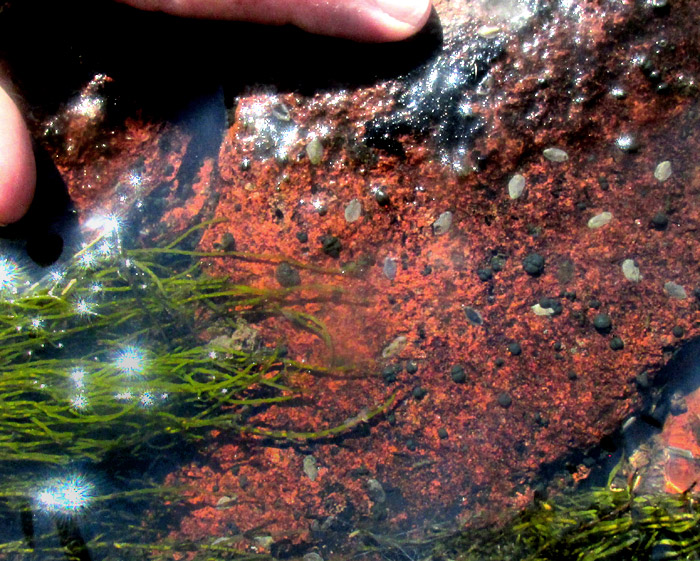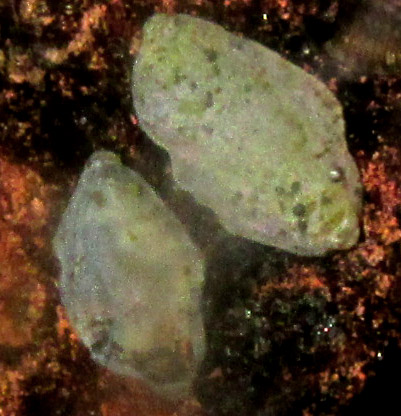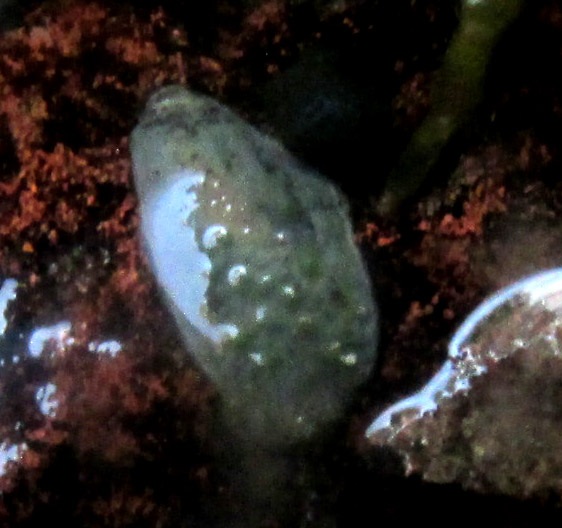Excerpts from Jim Conrad's
Naturalist Newsletter
Entry dated November 7, 2023, from notes taken at Cascadas de La Piedad waterfall 3kms NW of the community of San Pablo, municipality of Almeaco de Bonfil; bedrock of igneous andesite; N20.1008°, W100.0041°, elevation 2360 meters (7750ft); extreme southern Querétaro state, MÉXICO
AQUATIC FLATWORMS, MAYBE... OR MAYBE NOT...

Even during the ongoing two-year dry period classified by the "North American Drought Monitor" as an extreme D3 drought, a small stream of clear, cold water meandered across a livestock-grazed meadow atop a bed of pinkish, igneous andesite rock. Just before tumbling over a high ledge to create the picturesque Cascada de La Piedad, or Piety Waterfall, the above colony of small, rubbery-looking, rice-grain-shaped creatures gathered in cold, flowing water on rocks near the water's surface. The green, hairlike organism is the green alga known as Fragile Stonewort.

Up close, at first I thought the organisms might be planarians, such as those encountered earlier in a similar stream in Texas, which possibly were Girardia tigrina. If you compare that species with our Mexican stream denizens you'll note that planarians usually display cross-eyed-looking eyes, and ear-like side flaps at their heads. What at first looked like eyes on our Mexican items closer up are seen as warty bumps, plus there's no hint of head flaps.

Our streamside gray blobs gathered where water was the shallowest, where water extended onto gradually sloping rocks. There, as seen above, the backs of some individuals rose slightly above the water's surface, where reflected light emphasized the backs' bumpiness. Even so close, there's no hint of eyes or head flaps.
Planarians are just one of several kinds of flatworm, flatworms constituting the phylum Platyhelminthes. Phyla are huge subdivisions. There's the phylum of all vertebrate animals, the sponge phylum, the mollusk phylum, etc. Therefore, numerous flatworm families, genera and species are recognized, and quite a few look a bit like planarians without obvious eyes and head flaps. Many flatworm types are very similar to one another because of convergent evolution.
Atop all that, such organisms exist as freshwater slugs of the mollusk taxonomic clade Acochlidiacea. These can be quite similar to our Mexican critters, except that slug adults bear tentacles, though apparently on young the tentacles may not show. Even juvenile leeches might look like our streamside rubbery blobs.
In short, after reviewing many, many images of all kinds of freshwater invertebrate possibilities, I have no idea what's shown in our above photos, and can only guess that they may be some kind of freshwater flatworm of the phylum Platyhelminthes, though maybe not.
If anyone has an idea, let me know.